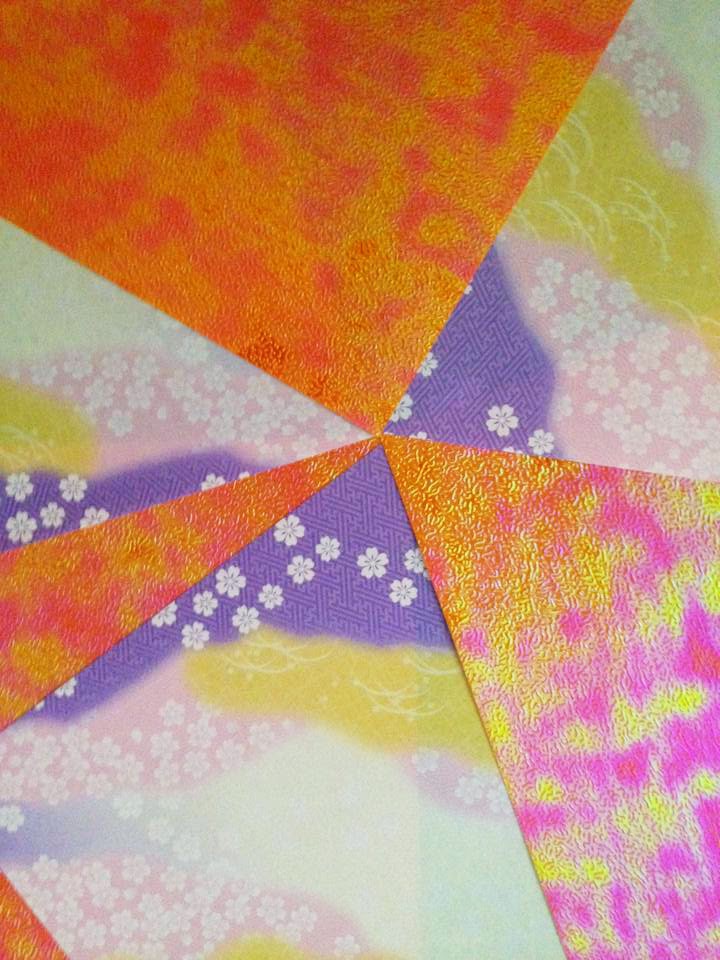 The first iteration was more of an interesting process than a complete success in finishing the figurine.Now, I already owned a few origami supplies myself (first picture, left). I wanted to see other selections of patterns and styles so going to Daiso was an ideal place to find all this (second picture, left). I grabbed
what I thought was appropriate at the time since I was still unsure of
what figurine to create.
The first iteration was more of an interesting process than a complete success in finishing the figurine.Now, I already owned a few origami supplies myself (first picture, left). I wanted to see other selections of patterns and styles so going to Daiso was an ideal place to find all this (second picture, left). I grabbed
what I thought was appropriate at the time since I was still unsure of
what figurine to create. It wasn't until I did more research (e.g. youtube tutorials, personal blogs, etc.) that I decided on my first iteration's figurine: the kusudama. What is the kusudama? The actual word means "medicine ball" in the Japanese language (Lukasheva 7). They were possibly used as incense in Japan since they were made from herbs (Lukasheva 7). In the origami culture, there appears to be various versions or variations of the kusudama as you can see here. The model I chose to create is called Estrella Flor which was created by Erny. Here is the tutorial I used.
I specifically chose to mix different styles of paper. For this model, I decided on traditional patterns with paper that reflected bright colors (as seen on the right). I thought it would be an interesting contrast, especially with the glittering orange accompanied by the other paper's hues of purple, pink, and yellow. The flowers from the patterns seem to add more to the aesthetic appeal. It wasn't until midway of the process that I realized there wasn't enough paper to use. Hence, the additional colors that was added later on. Hopefully the combination of all these different papers doesn't seem too random. As for the folding process, it wasn't as difficult as I had expected it to be. It was quite repetitive and by the third folded model, I had already memorized the steps from the video. Patience was definitely a large factor in creating the whole structure. I originally thought the required thirty sheets of paper wasn't too laborious. Five hours later I changed my mind.
It wasn't until I reached the assembling step that I experienced a problem... or problems. I noticed an extra triangle in the main point of my model. I had 6 points while the video showed 5 points. That's when I realized I might have accidentally made more structures than necessary. Even so, I think assembling it all should still be doable. I tried various combinations and ways but sadly, I couldn't accomplish it. My figurine kept shifting the whole time. I noticed the video's kusudama didn't shift the slightest.
That's when I realized several possibilities for the cause:
1) My inaccurate folding during the process.
2) The cutting of the origami papers into two equal sized strips might have been uneven.
3) The different thickness of the papers.
Towards the end, I experienced some difficulties and realized several mistakes. I wasn't able to complete the figurine but I am somewhat content with the result below. Hopefully I can complete the second iteration with more success. Until then, I'll enjoy the attempted kusudama I've accomplished.
Sources:
Lukasheva, Ekaterina. "Preface." Kusudama Origami. : , . . Print.










Hi Silvia
ReplyDeleteI like the colours of your final project, as well as your final process of your first iteration. I find that origami can be done in so many ways, but I love the kusudama idea by not only the complexity behind it, but also an aesthetic beauty behind the object as well. Keep up the good work.
Thank you Angus!
DeleteYou're right, origami can be done in so many ways. I had a bit of a hard time narrowing down which figurine I wanted to create. I wasn't sure if I should do another version of kusudama for the second iteration but personally I want to try something new. Hope your project is going well!
Hey Sylvia!
ReplyDeleteI love your first attempts to making origamis and how you've decided to go along with a 3D origami instead of a flat origami as well as using different materials to showcase the beauty of it. I am looking forward to seeing the rest of your iterations and what else you come up with! Good job
Hi Silvia,
ReplyDeleteI like your inspiration project. The last image’s patterns and composition looks great. Thank you for sharing with us. I don’t have patience for this part, because folding paper always drives me crazy when I was a child…